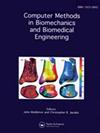基于gru的动力假肢足部位置预测的方差分析和线性回归特征选择。
IF 1.6
4区 医学
Q3 COMPUTER SCIENCE, INTERDISCIPLINARY APPLICATIONS
Computer Methods in Biomechanics and Biomedical Engineering
Pub Date : 2025-09-19
DOI:10.1080/10255842.2025.2558026
引用次数: 0
摘要
本研究使用方差分析和线性回归来评估特征选择,以优化基于gru的模型,用于预测动力假肢在不同地形上的足部位置。在MATLAB中对10名健康参与者在行走、上下楼梯和站立时的运动数据进行处理。选择的特征与递归特征消除进行比较,在混合数据集上训练GRU网络,并在独立受试者上进行测试。结果表明,方差分析和回归可以有效地选择特征,减少了计算量,性能相当。GRU实现RMSE低至0.066弧度,显示出鲁棒泛化。虽然很有希望,但在截肢者身上进行临床验证仍然是必要的。本文章由计算机程序翻译,如有差异,请以英文原文为准。
ANOVA and linear regression feature selection for GRU-based foot position prediction in powered prostheses.
This study evaluates feature selection using ANOVA and Linear Regression to optimize GRU-based models for predicting foot position in powered prostheses across varied terrains. Kinematic data from ten healthy participants during walking, stair ascend/descend, and standing were processed in MATLAB. Selected features, compared with Recursive Feature Elimination, trained GRU networks on mixed datasets and were tested on independent subjects. Results showed ANOVA and regression efficiently selected features with reduced computation and comparable performance. The GRU achieved RMSE as low as 0.066 radians, demonstrating robust generalization. While promising, clinical validation on amputee subjects remains necessary.
求助全文
通过发布文献求助,成功后即可免费获取论文全文。
去求助
来源期刊
CiteScore
4.10
自引率
6.20%
发文量
179
审稿时长
4-8 weeks
期刊介绍:
The primary aims of Computer Methods in Biomechanics and Biomedical Engineering are to provide a means of communicating the advances being made in the areas of biomechanics and biomedical engineering and to stimulate interest in the continually emerging computer based technologies which are being applied in these multidisciplinary subjects. Computer Methods in Biomechanics and Biomedical Engineering will also provide a focus for the importance of integrating the disciplines of engineering with medical technology and clinical expertise. Such integration will have a major impact on health care in the future.

 求助内容:
求助内容: 应助结果提醒方式:
应助结果提醒方式:


